Discovering Rolling Shoes for Adults: Features and Style
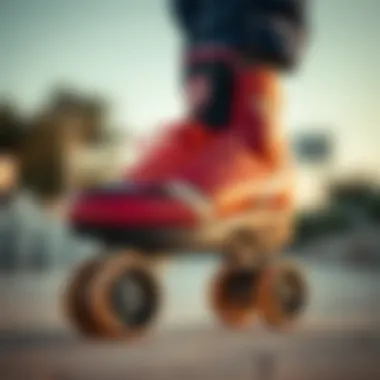
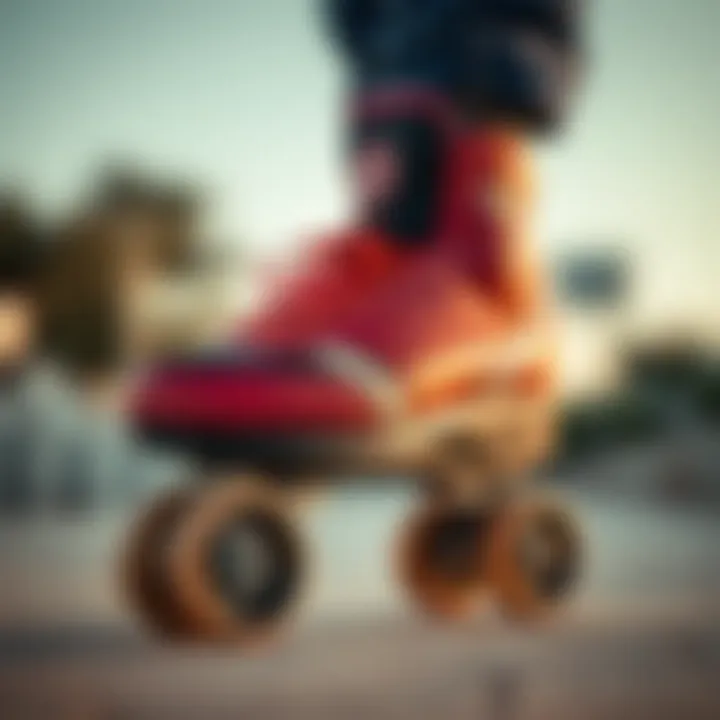
Intro
In recent years, rolling shoes have emerged as a popular choice for adults seeking both an active lifestyle and a unique way to express themselves. Unlike traditional inline skates or skateboards, these shoes combine the basic principles of skating with comfortable footwear design, making them a versatile choice for both leisure and skill development.
Rolling shoes allow users to glide smoothly, adding a stylish twist to physical activity. But before you lace up a pair, it’s crucial to grasp the intricacies behind their function and aesthetic appeal. Understanding these elements can significantly enhance your experience and safety while navigating through busy streets or skating rinks.
As we delve deeper, this guide will explore not only the essential features of rolling shoes but also how to choose the right pair for your needs, balancing function and style. Whether you're a casual skater or an ambitious enthusiast, let’s roll into the details that matter in your quest to find the perfect fit.
Understanding Rolling Shoes
In recent years, rolling shoes have emerged as a fascinating hybrid between traditional footwear and skating gear. Understanding what rolling shoes are, their unique features, and their historical roots offers essential insights for anyone from casual skaters to seasoned instructors. These shoes have become more than just a means of mobility; they symbolize a lifestyle centered on freedom, movements, and style.
The significance of comprehending rolling shoes spans several factors. First and foremost, it allows users to appreciate their multi-functional design. Unlike standard shoes, which serve merely as protectors for the feet, rolling shoes integrate wheels into their structure. This incorporation not only caters to recreational skating but also opens avenues for fitness and competitive use. Ever heard someone say "two birds with one stone"? That's the realization that rolling shoes have brought to the table; you can look stylish while enjoying outdoor activities and improving your fitness.
Moreover, an adequate understanding of rolling shoes informs consumers about the various types available. Whether you’re eyeing casual rolling shoes for leisurely weekend strolls or performance-oriented models for skate parks, recognizing the distinctions can guide your choice. Additionally, knowledge about safety considerations and maintenance routines ensures a longer lifespan for these innovative shoes.
Definition and Features
Rolling shoes are a spirited blend of sneakers and roller skates, boasting features that cater to both comfort and performance. At their core, they typically consist of a supportive upper portion, functional wheels embedded in the sole, and a cushioned insole that allows for smoother rides on various surfaces.
Some standout features include:
- Wheels: Most rolling shoes come equipped with durable wheels meant for various terrains, whether that be asphalt or smooth indoor floors.
- Breathable Materials: To maintain comfort, manufacturers often use lightweight and breathable fabrics. This helps your feet stay cooler during those long rides.
- Secure Fit: With adjustable straps or laces, rolling shoes ensure a snug fit, allowing users to skate without fear of slipping.
Historical Perspective
Rolling shoes have their roots embedded in the rich heritage of skating history. The concept of attaching wheels to footwear dates back several centuries, with the first documented roller skate reportedly crafted in the 18th century. It wasn't until the late 20th century that the market saw a significant shift towards recreational and performance-centric rolling shoes.
As skateboarding gained popularity in the 1970s and 1980s, innovations in rolling shoe design began to flourish. Key advancements came through the introduction of lighter materials and improved wheel technology, offering skaters enhanced control and performance. Over time, rolling shoes evolved to include designs that fuse vibrant aesthetics with practical functionality. Today, they represent not only a mode of transport but also a cultural aesthetic associated with urban lifestyles.
Design Elements of Rolling Shoes
Understanding the design elements of rolling shoes is fundamental to enhance the skating experience. The right combination of materials, construction, and integration of wheels contributes significantly to both performance and comfort. It's not just about looking good while skating; it’s about feeling good too. Getting accustomed to various designs helps in making an educated decision when choosing the right pair of rolling shoes.
Materials Used
The materials used in crafting rolling shoes play an essential role in their overall functionality as well as durability. More than just aesthetics, the choice of material can impact weight, flexibility, and breathability of the shoe. High-quality synthetic leather or breathable mesh often replaces traditional materials. These materials provide versatility, allowing skaters to maximize performance while ensuring comfort.
- Synthetic Leather: This material is often favored due to its water-resistant properties, allowing for different weather conditions without sacrificing comfort. It also requires less maintenance compared to natural leather, but it might not be as flexible.
- Mesh: Used primarily in the upper sections, mesh allows for better air circulation. This is crucial during prolonged use, helping to keep feet cool and preventing moisture buildup. However, mesh may be less durable in certain conditions, impacting longevity.
These materials together create a shoe that is both functional and comfortable.
Anatomy of Rolling Shoes
Examining the anatomy of rolling shoes reveals the intricate details that contribute to their performance and comfort. Each element serves a purpose, aligning with the skater's needs for durability, balance, and style.
Upper Construction
The upper construction of rolling shoes entails the part of the shoe that encases the foot. A well-constructed upper not only offers support but also contributes to the overall fit. Many upper constructions utilize straps and lace systems to allow for customizable tightening, which helps maintain a snug fit during various skating maneuvers. One key characteristic to note is the incorporation of padded collars and cushioning on the tongue, which can significantly enhance comfort.
- Popular Choices: Shoes that feature reinforced sections often provide better support, particularly at the ankle area.
- Unique Features: Some models offer a quick-lace system that allows skaters to adjust tightness with a simple pull, making it a practical choice for those on the go. However, while these may seem convenient, they can sometimes compromise on long-term durability.
Sole Composition
Delving into the sole composition provides insight into traction, stability, and support. The soles are a critical component that impacts how well skaters maintain contact with the ground. Various types of rubber compounds are integrated to enhance grip, which is crucial for maneuvering.
- Key Characteristic: A good quality sole often combines hard and soft rubbers, creating a balance that offers both durability and grip on multiple surfaces.
- Unique Feature: Some rolling shoes come with shock-absorbing soles that help reduce the impact on joints during skating, an advantage for skaters who enjoy long sessions. However, a more cushioned sole may relinquish some sensitivity and control over the skating surface.
Wheel Integration
The integration of wheels in rolling shoes is a technical aspect that greatly influences performance. Understanding the variability in wheel size and type becomes essential in optimizing the skating experience. Most shoes come equipped with wheels that range in diameter, influencing both speed and agility.
- Key Characteristic: Larger wheels typically provide a smoother ride over rough surfaces, while smaller wheels offer more maneuverability, making them ideal for performing tricks or navigating tight corners.
- Unique Feature: Some designs integrate replaceable wheel systems that allow skaters to customize their ride according to personal preferences or skill levels. While this flexibility can be beneficial, it often raises questions about compatibility and ease of replacement for skaters who are not as experienced.
In summary, understanding the elements of rolling shoes can greatly enhance both the comfort and functionality for those who partake in skating, ensuring that the right choice is made based on individual needs and preferences. This intrinsic knowledge will not only aid skaters but also shop owners and instructors in guiding novice skaters toward informed decisions.
Comfort and Fit Considerations
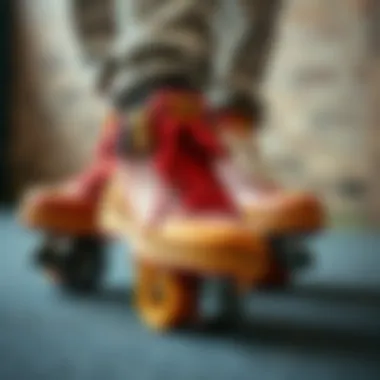
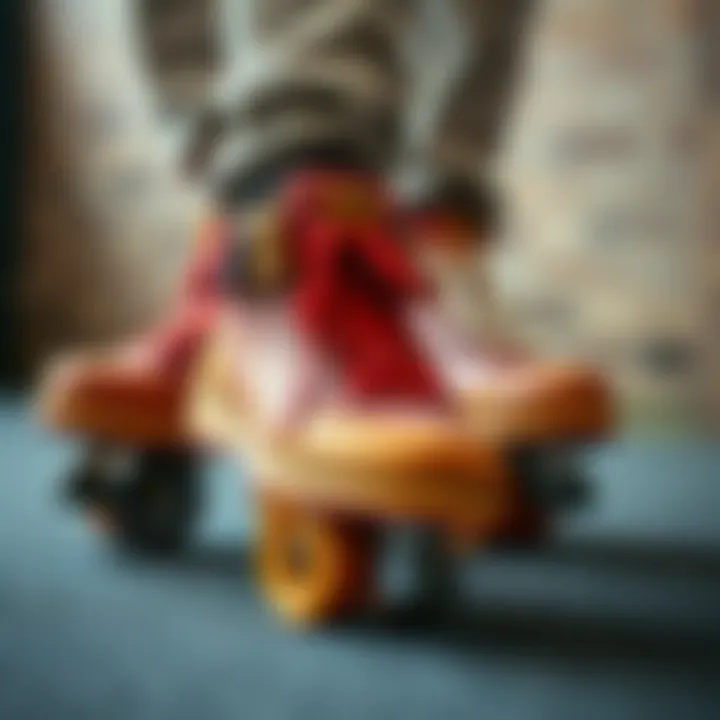
When diving into the world of rolling shoes, comfort and fit become paramount. It's not just a matter of slipping on a pair and heading out the door; the right fit can enhance your skating experience significantly. Poorly fitting shoes can lead to discomfort and even injuries, diminishing the joy of skating. Thus, understanding how to choose the right size and adjust your shoes according to your individual needs is essential for any adult engaging in this activity.
Sizing Guidelines
Getting the size right is no small feat. Each manufacturer may have different sizing standards, so it’s crucial to measure your feet accurately. Here are a few key points to consider when determining your size:
- Measuring Foot Length: Use a ruler or tape measure to determine the length of your foot from heel to toe. Make sure to do this while standing, as your feet may spread out a bit under your weight.
- Width Considerations: The width of your foot also matters. Certain brands offer wide or narrow versions of their shoes, accommodating varying foot shapes. If your feet are on the broader side, keep an eye out for these options.
- Try Before You Buy: If possible, try on different sizes. Rolling shoes should fit snugly but not be overly tight. You should have a little wiggle room in your toes, but your heel should not lift out of the shoe.
- Socks Make a Difference: Don’t forget about the type of socks you wear. They can affect the fit. Always try on shoes with the kind of socks you would typically wear while skating.
With this in mind, it’s clear that an accurate sizing process can not only prevent blisters but also contribute to better control while rolling.
Adjustment Features
Once you've found your size, the next step is to look for adjustment features that provide further customization. Here’s what to keep in mind:
- Lacing Systems: Many rolling shoes come with advanced lacing systems that allow you to tighten or loosen the fit easily. This feature is especially important for achieving that perfect snugness around the ankle, which can enhance support and reduce the risk of twisting or spraining.
- Buckle Adjustments: Some models use buckle systems in addition to or instead of traditional laces, giving an even more secure fit. This is particularly beneficial in performance-oriented models where precision is key.
- Tongue Padding: A well-padded tongue can prevent laces from digging into the top of your foot, enhancing comfort. Check for shoes that offer this feature, as it can make all the difference during extended use.
- Insole Variability: The insoles on rolling shoes can often be adjusted as well. Many brands offer removable insoles, allowing you to replace them with custom orthotics if necessary. This is particularly valuable for those who require extra arch support.
Understanding your own foot shape and how it interacts with various adjustments can go a long way in ensuring that your skating experience remains enjoyable and pain-free.
"A good pair of rolling shoes is like a second skin; it should fit so well that you forget you’re wearing them."
When it comes to rolling shoes, neither comfort nor fit should be an afterthought. They are foundational elements that contribute to safety and performance, making them worthy of careful consideration.
Safety Aspects of Rolling Shoes
In the world of rolling shoes, safety isn't just an option; it's imperative. Regardless of whether someone is a casual skater or a dedicated enthusiast, making informed decisions about safety elements can prevent serious injuries and enhance the overall experience. Rolling shoes, while offering freedom and fun, can also lead to some risky situations. Thus, understanding safety considerations is paramount. Skating often comes with its fair share of falls. These mishaps can occur to even the most experienced skater. By taking proper precautions, individuals can mitigate these risks significantly.
Protective Gear
Wearing protective gear when skating is not merely a choice; it’s a cautious commitment to one’s own safety. While rolling shoes are designed for stability, they don’t provide a safeguard against all dangers of rolling. Key items of protective gear include:
- Helmets: A significant safeguard, helmets protect the head from severe injuries caused by falls or collisions. Opt for helmets recognized for meeting safety standards; a cheap helmet isn’t worth the potential cost of brain injury.
- Knee and Elbow Pads: These pieces provide cushioning on hard surfaces and protect against scrapes and bruises. They are essential, especially for beginners who are still adjusting to their balance.
- Wrist Guards: These are particularly helpful for preventing wrist fractures, a common injury among skaters. A fall usually leads to instinctively extending the hands, which is where wrist guards come into play.
By donning this gear, a skater can greatly reduce the risks associated with rolling.
Accident Prevention Measures
Taking a few proactive measures can prevent accidents before they occur. These practices are just as crucial as selecting the right rolling shoes:
- Inspecting the Skates: Before hitting the pavement, checking the condition of the rolling shoes is essential. Look for loose wheels, damaged brakes, or any other wear and tear that could lead to accidents. Like with any athletic gear, a stitch in time saves nine.
- Choosing Safe Locations: Not every surface is suitable for rolling shoes. Freshly paved paths or parks provide ideal spaces to enjoy skating, while busy roads or uneven surfaces pose significant risks. Always scout the area before skating.
- Staying Aware of Surroundings: It’s easy to get lost in the thrill of skating, but being mindful of people, pets, and obstacles is vital. Awareness can determine how swiftly one reacts to imminent hazards.
Each of these preventative measures, combined with the right protective gear, creates a safer environment for anyone wishing to enjoy rolling without the constant worry of injury. Safety should be as much a part of skating as the joy of gliding itself.
"Wearing gear may seem cumbersome, but it comes with the peace of mind that allows skaters to express their skills freely."
Types of Rolling Shoes
Understanding the different types of rolling shoes is crucial for anyone who’s serious about skating or leisurely rolling. The market has matured with multiple categories, each serving a unique purpose and audience. Knowing these distinctions can enhance your riding experience, allowing you to select shoes that not only meet your needs but elevate your performance.
Recreational Rolling Shoes
Recreational rolling shoes are often the entry point for many skaters. These models are usually designed with comfort in mind, rather than aggressive performance. They are crafted using soft materials that offer a gentle feel on the foot, making them suitable for longer sessions. Their primary aim is to facilitate a smooth and enjoyable ride while prioritizing ease of use.
Key features typically found in recreational models include:
- Cushioned insoles: Providing support for the arches and heels.
- Lightweight frames: Ensuring that the user doesn’t feel bogged down while rolling.
- Beginner-friendly wheels: Generally soft with a larger diameter for smoother rides over uneven surfaces.
This type of shoe is ideal for those looking to enjoy local parks, practice leisurely skating, or simply cruise around town. It allows users to enjoy the experience without the intimidation of performance-driven features.
Performance-Oriented Models
Shifting gears, performance-oriented shoes are where technology meets serious skating. They are engineered for those who seek speed, agility, and maneuverability. Often used in competitive environments, these shoes come equipped with advanced tech to optimize the skating experience.
Look for:
- Harder wheels: This type results in less drag and higher speed, suitable for smooth surfaces like rinks or competitive tracks.
- Stiffer boots: They provide better ankle support, crucial for executing sharp turns and performing tricks with confidence.
- High-grade abrasion-resistant materials: These keep your shoes intact even in rugged skating conditions.
For dedicated skaters, these shoes are non-negotiable. They can dramatically affect one’s ability to push the limits while maintaining comfort, showcasing the blend of form and function. Performance shoes can often feel more restrictive, but they’re built for stability and longevity.
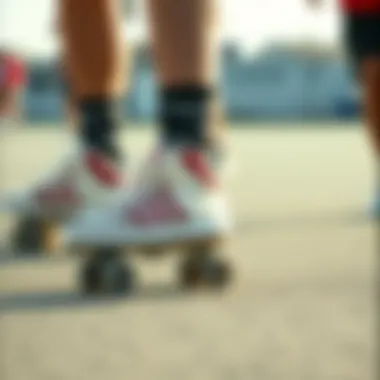
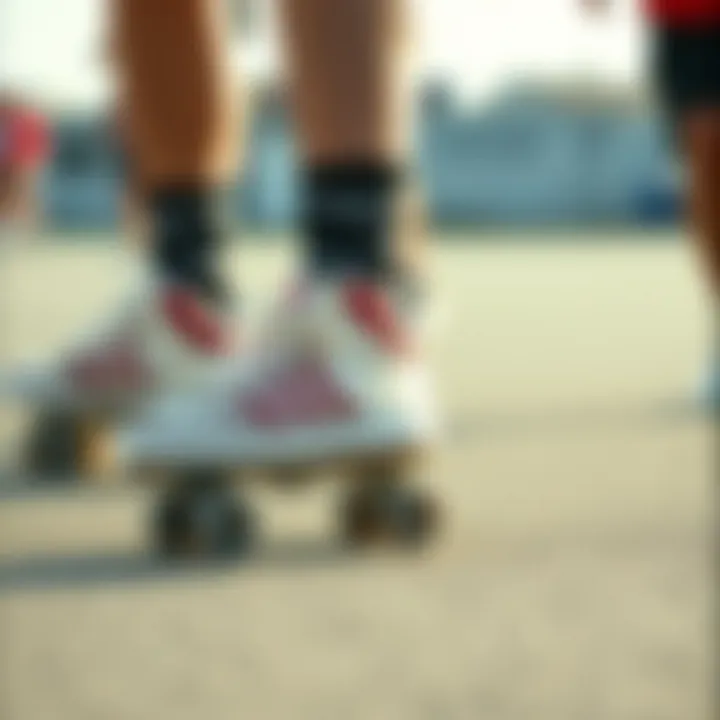
Hybrid Designs
Finally, hybrid designs bring together the best of both recreational and performance-oriented shoes. These models cater to those who enjoy various skating styles and aren't confined to a single type of performance. They can navigate urban settings with ease, while still being robust enough for occasional speed pursuits.
Characteristics of hybrid shoes can include:
- Versatile wheel compositions: Offering both speed and grip to handle everything from city streets to smooth park tracks.
- Adaptive fit systems: Often feature adjustable components, catering to different foot shapes and sizes.
- Stylish yet functional aesthetics: These shoes let you skate in style, merging functionality with trendy designs.
Such versatility makes them an excellent choice for casual skaters who want to explore different terrains without needing to invest in multiple pairs. It’s a one-stop solution tailored to diverse skating needs.
"Choosing the right type of rolling shoe can transform your skating experience, making it more enjoyable and tailored to your personal style."
Ultimately, selecting the appropriate type of rolling shoe is fundamental. It shapes not just your performance but your overall enjoyment in skating. Understanding these distinctions empowers you to make informed choices that align with your skating ambitions.
Choosing the Right Rolling Shoes
Selecting the right rolling shoes is like finding the perfect partner for an adventure. It’s essential to consider not just the style but also the comfort and functionality that meet your individual demands. Rolling shoes come in various forms, each designed for specific uses and preferences, thus understanding what you need can transform your skating experience whether you are a leisurely skater or someone looking to perform.
Assessing Personal Needs
Everyone has unique preferences and requirements when it comes to rolling shoes. First, you might want to ponder on the primary use; are you going for casual rides in the neighborhood or gearing up for intense skate sessions?
- Purpose: If casual, look for shoes that emphasize comfort but still have solid wheels. For performance, prioritize shoes with good ankle support and stability.
- Terrain: Think about where you’ll be rolling. Smooth surfaces might need different considerations compared to rough terrains that require more substantial tread.
- Frequency: How often will you use them? If it’s every other day, investing in a durable pair may save you money in the long run, as opposed to a cheap option that might wear out quickly.
Your needs can dictate not just the model but also the fit. Ensuring that your rolling shoes hug your feet without being too tight is crucial. A snug fit can prevent blisters, while loose shoes might affect both performance and safety.
Brand Comparisons
When discussing rolling shoes, the brand can be as pivotal as any other factor. Some brands have a track record that stands out due to quality, innovation, or customer satisfaction.
Reputable Brands
Let’s talk about reputable brands such as Rollerblade and K2. These brands have a long-standing reputation in the skating world. Their shoes are often designed based on extensive user feedback.
- Key Characteristic: Their commitment to quality materials impacts both durability and comfort.
- Unique Feature: Many offer customizable fit systems where users can adjust straps and lacing, which enhances the overall experience.
A downside might be the price point; these brands often come at a premium. However, the investment can pay off through longevity and performance. In contrast to lesser-known brands that might underperform and lead to missed opportunities on the rink.
Emerging Labels
Emerging labels like Moonlight and PureRoller are shaking up the market. What sets them apart is their innovative designs and fresh approaches to aesthetics and functionality.
- Key Characteristic: Many incorporate eco-friendly materials or novel designs, appealing to environmentally conscious skaters.
- Unique Feature: Some have implemented unique wheel technologies that enhance glide and speed, making them attractive to speed-focused riders.
While they might lack decades of established trust compared to their more seasoned counterparts, the value lies in their potential for innovation. However, one must tread cautiously and seek reviews before diving in headfirst.
"Investing in the right shoes not only ensures comfort but also enhances your performance on the road and your confidence as a skater."
For more about rolling shoes, check additional resources such as Wikipedia on Roller Skates or Reddit’s Skating Communities.
It’s essential to keep your options open and consider varied brands when making your purchase.
Maintenance and Care
Taking care of rolling shoes goes far beyond just keeping them clean. Proper maintenance and care ensure that these valuable accessories not only last longer but also perform better, allowing you to have a seamless experience on wheels. When neglecting upkeep, issues like wear and tear or reduced functionality frequently arise. After all, nobody wants to be caught off guard on a fun outing just because shoes don't hold up.
Cleaning Techniques
Regular cleaning of rolling shoes is fundamental. The materials used in these shoes can trap dirt, grime, and moisture, which can eventually affect their performance. Here are a few effective cleaning techniques:
- Wipe Down After Use: A quick wipe with a damp cloth after every use can go a long way. This helps in removing dirt particles and sweat that might otherwise settle in.
- Deep Cleaning: For a more thorough clean, use a gentle soap solution. Mix water with a mild detergent and softly scrub the surfaces. Pay special attention to the wheels; a dirty wheel can compromise your speed and control.
- Disinfect: It’s not just about aesthetics. Disinfecting your shoes, especially the inner lining, can prevent any unwanted odors or fungal growth. Use a spray designed specifically for footwear.
Storage Best Practices
Storing your rolling shoes correctly is another vital factor in their longevity. Improper storage can lead to deformation and permanent damage. Here are some sound practices:
- Cool, Dry Place: Always store your shoes in a place that’s away from moisture and direct sunlight. A cool and dry environment helps in maintaining the integrity of the materials.
- Use Shoe Trees or Inserts: Placing shoe trees or inserts can help maintain the shape of your shoes while not in use. This is particularly useful if you have leather or fabric shoes that can lose their form.
- Avoid Stacking: Try not to stack heavy items on top of your shoes. This can create unnecessary pressure and make your shoes lose their structure.
Proper care of rolling shoes is not just a minor detail; it can determine your overall skating experience. Keep them clean and store them well to enjoy the ride longer.
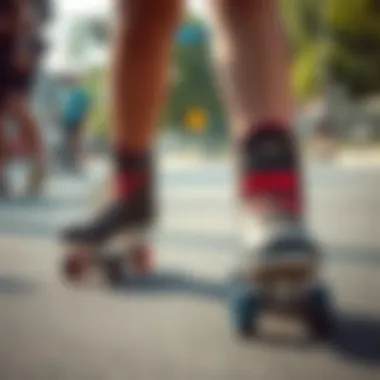
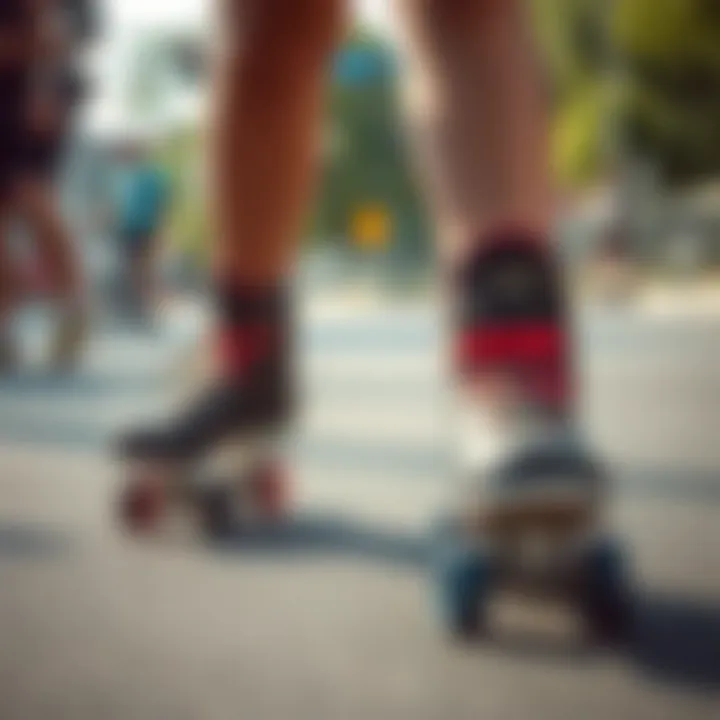
Incorporating a maintenance routine will not only save you money in the long run but also promote safety. After all, you wouldn’t want your shoes to fail you when you’re racing down a hill or trying out new tricks. The more attention you give your rolling shoes, the better the performance you’ll enjoy.
Innovations in Rolling Shoes
One cannot overlook the rapid evolution of rolling shoes in recent years. As skating continues to gain traction worldwide, these innovations are not solely about flash; they’re rooted in enhancing performance, safety, and sustainability. For serious skaters and recreational users alike, the latest advancements in rolling shoes translate directly to improved experiences on the rink or city streets.
The combination of modern materials and cutting-edge designs is shaping the way we think about comfort and functionality. It’s not just about rolling around anymore; it’s about rolling with purpose. This section will delve into some critical innovations, focusing on technological advancements and sustainability efforts.
Technological Advancements
Innovative technology has always been an intrinsic part of skate culture, and rolling shoes are no exception. One of the standout features today is the integration of smart technology. Various brands are introducing shoes equipped with sensors that collect data on your skating style and performance metrics. This information allows skaters to adjust their techniques and improve over time. Leveraging technology like this can turn an ordinary skate into a personal coach.
Another fascinating advancement is the development of hybrid materials. Combining lighter-weight plastics with high-quality fabrics enables manufacturers to create rolling shoes that are both durable and lightweight. This change significantly reduces fatigue, especially for those who spend hours skating.
"The perfect rolling shoe is like a well-written story; it brings together various elements seamlessly, allowing the skater to become part of the narrative."
To improve grip and stability, many new models now feature innovative wheel designs. These wheels often utilize a unique urethane composition that provides better traction while reducing noise. Furthermore, some brands have incorporated adjustable wheel features, which let users swap out wheels based on their skating conditions. One day you might be gliding through the park, while the next finds you on a slick indoor rink, and the ability to adapt is key to maximizing performance.
Sustainability Efforts
In this day and age, considering sustainability is as crucial as any technical specification. As eco-conscious practices permeate every industry, rolling shoe manufacturers are stepping up to the plate. Many brands are now sourcing materials from recycled products, reflecting a collective commitment to reducing waste.
For example, some companies have begun to produce shoe components from recycled plastics or rubber, which not only conserves resources but also limits the environmental footprint of their production processes. This shift is more than just a marketing ploy; it represents a growing trend among consumers who prioritize eco-friendly products.
Moreover, brands are also adopting sustainable packaging solutions. This change may seem subtle, but packaging made from biodegradable or recyclable materials can significantly lessen a brand's environmental impact. As the saying goes, small steps lead to great journeys.
As time goes on, innovations in rolling shoes not only look to improve performance and safety but also address the planet’s pressing needs. By aligning technological advances with sustainable values, the industry is paving the way for a future where users can skate with both confidence in their gear and pride in their choices.
Cultural Impact of Rolling Shoes
The cultural impact of rolling shoes transcends mere functionality and extends into areas such as community, identity, and expression. As these shoes become a staple in various social circles, their role evolves into much more than just a mode of transport. Understanding this impact offers insight into how rolling shoes express personal styles and shape social interactions.
Role in Skating Communities
In the heart of skating communities, rolling shoes serve as badges of identity. They are not only essential for mobility but also a medium through which skaters express their uniqueness. Styles, colors, and brands can indicate personal preference or even affiliation with a group. For instance, a skater may favor FILA’s Rollerblade line for its retro flair, while another might choose Riedell for its performance capabilities in roller derby.
The camaraderie within these communities is palpable; rolling shoes foster a sense of belonging. Oftentimes in skate parks or urban environments, you’ll find groups gathered not just to skate, but to share experiences, develop techniques, and engage in friendly competition. This collaboration nurtures skills and builds friendships, strengthening the community bond.
Rolling shoes not only take us places; they connect us with others who share the same passion for skating.
Beyond the basics, rolling shoes can also influence the style language within the community. The choice of a customized or limited-edition skate shoe may become a point of pride among peers, leading to discussions not only about the shoes themselves but also about the values and stories behind them. Quality and aesthetics merge here, pushing skaters at every level to skillfully navigate cultural trends while maintaining personal style.
Representation in Media
Rolling shoes have made their way into various media formats, shaping perceptions and encouraging interest in skating culture. Movies like Roller Dogs and Lords of Dogtown highlight the exhilarating yet challenging world of skating, often showcasing the iconic rolling shoes that are at the center of these narratives. They elevate the activity beyond sport to a lifestyle that resonates with many.
The rise of social media platforms helps amplify this representation. Instagram accounts and YouTube channels dedicated to rolling shoes showcase both reviews and aesthetic inspirations, while influencers share tips and tricks for the best skating experiences. Often, what’s simple footwear becomes the highlight of a well-curated lifestyle choice, melding performance with expression.
Additionally, notable brands like Razor and Rollerblade capitalize on this visibility, effectively using sponsorships to align their image with prominent skaters. The symbiosis between brands and media furthers the appeal of rolling shoes, even reaching those who may not actively partake in skating but are drawn to its culture.
In summary, rolling shoes are not just practical. Their cultural impact reaches deep into social communities and the media, embodying both personal expression and collective identity in a way that resonates across generations. The continuous evolution of these elements gives us a glimpse into the rich tapestry that defines the world of rolling shoes for adults.
Future of Rolling Shoes
The realm of rolling shoes is rapidly evolving, and discussions about their future are not just about aesthetic choices or performance enhancements. Understanding the future of these shoes holds significance for various stakeholders, from enthusiasts to manufacturers. Rolling shoes are no longer merely tools for recreation; they are symbols of culture, self-expression, and innovation. As technology advances and consumer preferences shift, it's vital to explore how these changes will map out the rolling shoe landscape.
Market Trends
Observing current market trends is akin to peering into a crystal ball that hints at what is to come. One noticeable shift is the rising demand for personalized rolling shoes. Consumers are no longer just satisfied with the generic options they used to find. They seek customization to express their identity — a trend that's evident in the rise of companies like customskates.com, which allow users to design their shoes according to their style and performance needs.
There's also a growing emphasis on sustainability. The exploitation of natural resources is sparking discussions in every industry, and the rolling shoe sector is no exception. Brands are increasingly adopting eco-friendly materials. For instance, Rookie Skates has embraced recycled plastics. This pivot aligns with the broader consumer demand for environmentally responsible products, indicating that a keen eye on sustainability might just capture the hearts of eco-conscious buyers.
Additionally, the integration of technology into rolling shoes is becoming more pronounced. Smart features, such as performance tracking and well-being monitoring, are gaining traction. Imagine rolling shoes equipped with apps, which give real-time data on speed, endurance, and even calories burned while you glide down the park paths!
Future Innovations
The future innovations in rolling shoes are as thrilling as they are diverse. One area ripe for exploration is the combination of augmented reality (AR) and rolling shoes. This technology could allow users to interact with their environment and receive navigational support in real-time while skating. You could be riding through your favorite routes, and with a quick glance at your shoe, receive suggestions for the best paths or spots to do tricks.
Additionally, the advancement in materials science is pushing boundaries. Imagine rolling shoes created from adaptive materials that provide support where needed but remain lightweight. This innovation could lead to enhanced performance and reduced fatigue, a game changer for long-distance or professional skaters.
Moreover, we cannot overlook the potential integration of health monitoring systems right into the shoes. As wearables gain popularity, rolling shoes could soon track heart rate, pressure points on the feet, and overall stability, offering valuable insights to health-conscious users.
"Innovation in design and technology could pave new paths in skating, enhancing connections between the skater and the environment."
For more insights and updates, you can explore resources such as redbull.com or wheelsonfoot.com, to stay in the loop about the continuous evolution in the skates market.



